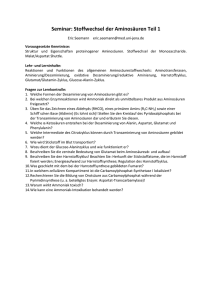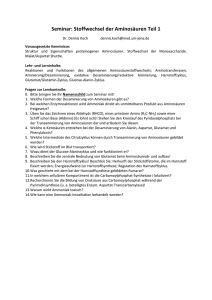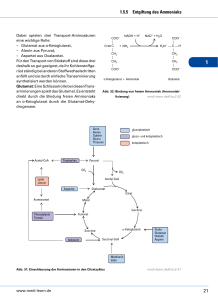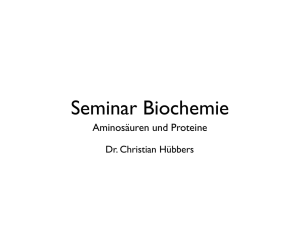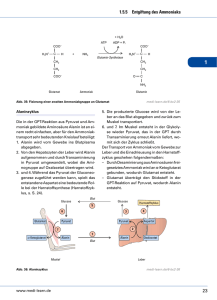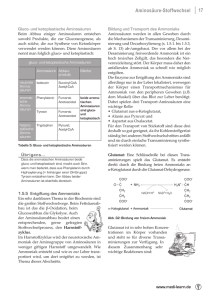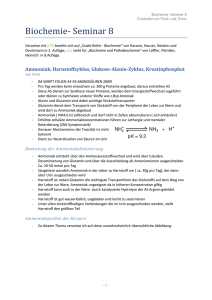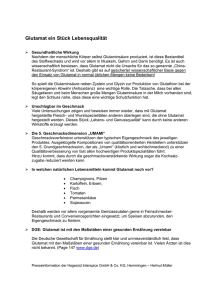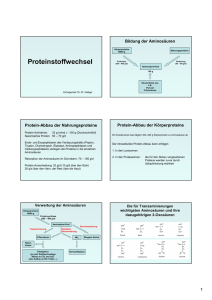Aminosäuren, Stickstoff, Harnstoffzyklus
Werbung
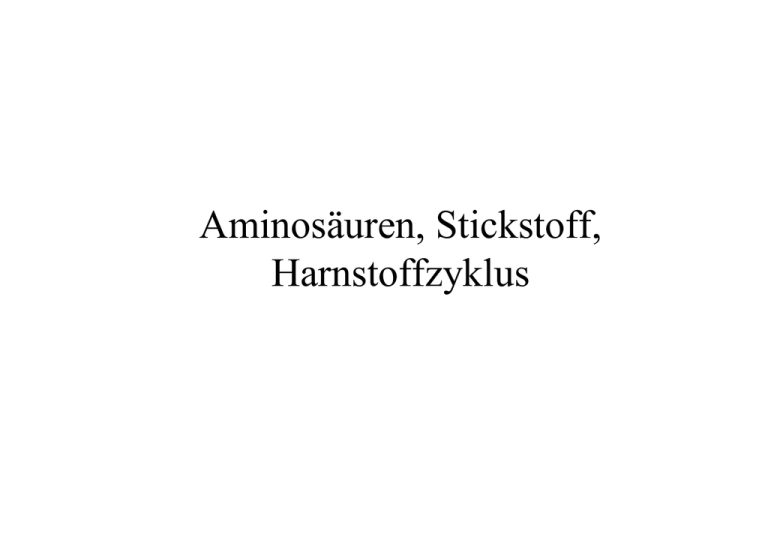
Aminosäuren, Stickstoff, Harnstoffzyklus Stickstoff-haltige Verbindungen Aminosäuren & Proteine Purine, Pyrimidine & Nucleinsäuren Biogene Amine (Histamin, Serotonin) Polyamine (Spermin) Kreatin Porphyrine Aminozucker Aminosäurepool Biosynthese Abbau von Körpereigenem Protein NahrungsEiweiß AS (100g) Gluconeogenese FS-Synthese NichtproteinSynthesen StickstoffAusscheidung Synthese von Körpereigenem Protein Fakten zum Protein-Stoffwechsel Für einen Menschen mit 70 kg Körpergewicht gilt: Protein-Gewicht: 10 kg Protein-Neusynthese: 300 g/Tag Obligater Stickstoffverlust (entsprechend 32g Protein) Ausgleich über die Nahrung (biologische Wertigkeit wichtig) Aminosäuremangel-Erkrankung: Kwashiorkor Aminosäurestoffwechsel Essentielle Aminosäuren: 8 Lysin, Methionin, Threonin, Isoleucin (Aspartatfamilie) Valin, Leucin (Pyruvatfamilie) Phenylalanin, Tryptophan (ShikimisäureFamilie) Exogene Proteolyse Endogene Proteolyse Zytosolisch: Proteasom-Abbau nach Ubiquitinierung Lysosomal: durch Hydrolasen (pH 3-7) Kathepsin B (Cys-Protease) Kathepsin D (Asp-Protease) Unterschiedliche Lebensdauer einzelner Proteine Möglichkeit der Regulation Aminosäurestoffwechsel Enge Verbindungen zum - Kohlenhydrat-Stoffwechsel - Fettsäure-Stoffwechsel Bedeutung der α-Ketosäuren Pyruvat, Oxalacetat, α-Ketoglutarat Glucogene vs. ketogene Aminosäuren Transaminierungs-Reaktion α-Ketosäure 1 + Aminosäure 2 ßà Aminosäure 1 + α-Ketosäure 2 Beteiligtes Enzym: Transaminase/Aminotransferase Beteiligtes Coenzym: Pyridoxalphosphat (Vit B6) Transaminierungsreaktion I Transaminierungsreaktion II Transaminierungsreaktionen Aspartat-Aminotransferase (ASAT) = Glutamat-Oxalacetat-Transaminase (GOT) Aspartat + α-Ketoglutarat ßà Oxalacetat + Glutamat Alanin-Aminotransferase (ALAT) = Glutamat-Pyruvat-Transaminase (GPT) Alanin + α-Ketoglutarat ßà Pyruvat + Glutamat Aminosäurestoffwechsel Aminosäuren sind durch ein Netz von Transaminierungs-Reaktionen miteinander verknüpft. Als Donator/Akzeptor des Aminostickstoffs dienen v.a. Alanin, Aspartat und Glutamat. Alanin ist der Haupttransportstoff für Aminogruppen im Blutplasma. Glutamat stellt die Drehscheibe des Aminostoffwechsels dar. Glutamat als Drehscheibe des Aminostickstoffs Fixierung von Ammoniak in Glutamat (& Glutamin) Beseitigung des Aminostickstoffs Toxizität von NH3: Ammoniakvergiftung (Flattertremor d. Hände, verwaschene Sprache, Sehstörungen) Ammoniakausscheidung: Ammonotelie Harnstoffausscheidung: Ureotelie Harnsäureausscheidung: Uricotelie Harnstoffzyklus = Krebs-Henseleit-Cyclus Stoffwechselweg der Leber Teils mitochondrial, teils cytosolisch Hauptbiosyntheseweg: 30g (0,5 mol)/Tag bei proteinreicher Nahrung: 90g (1,5 mol)/Tag Harnstoffzyklus I Mitochondrium Harnstoffzyklus II Mitochondrium Harnstoffzyklus III Genetische Harnstoffzyklus-Defekte Enzym Carbamyl-P-Synthetase Ornithintranscarbamylase Krankheit Hyperammonämie I Hyperammonämie II ArgininosuccinatSynthetase Argininosuccinat-Lyase Citrullinämie Arginase NAc-Glutamat-Synthase Arginin-BernsteinsäureKrankheit Hyperargininämie Nac-Glutamat-Mangel
